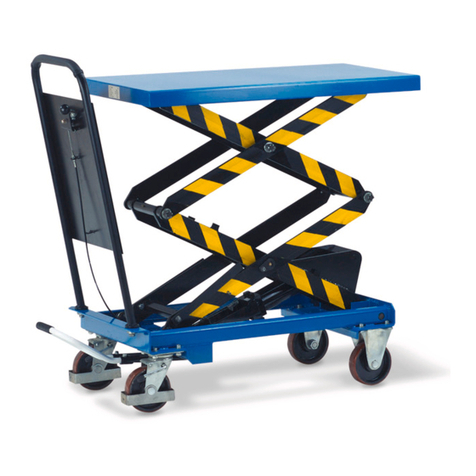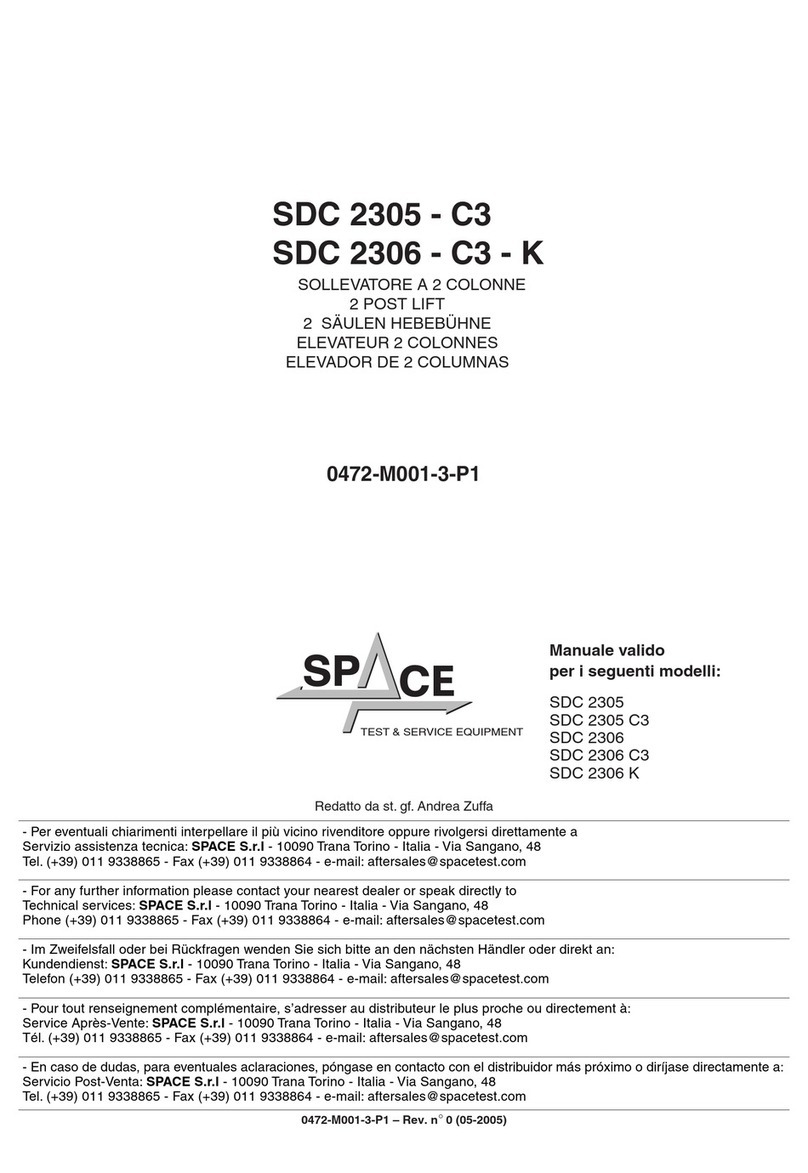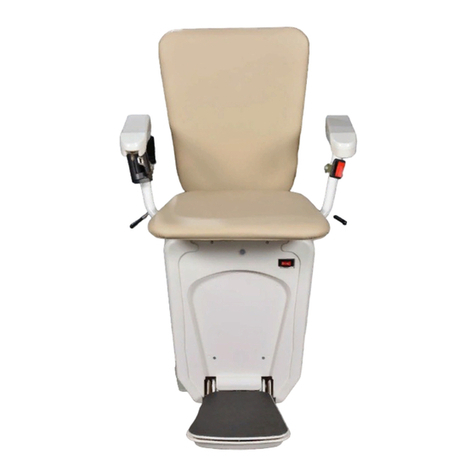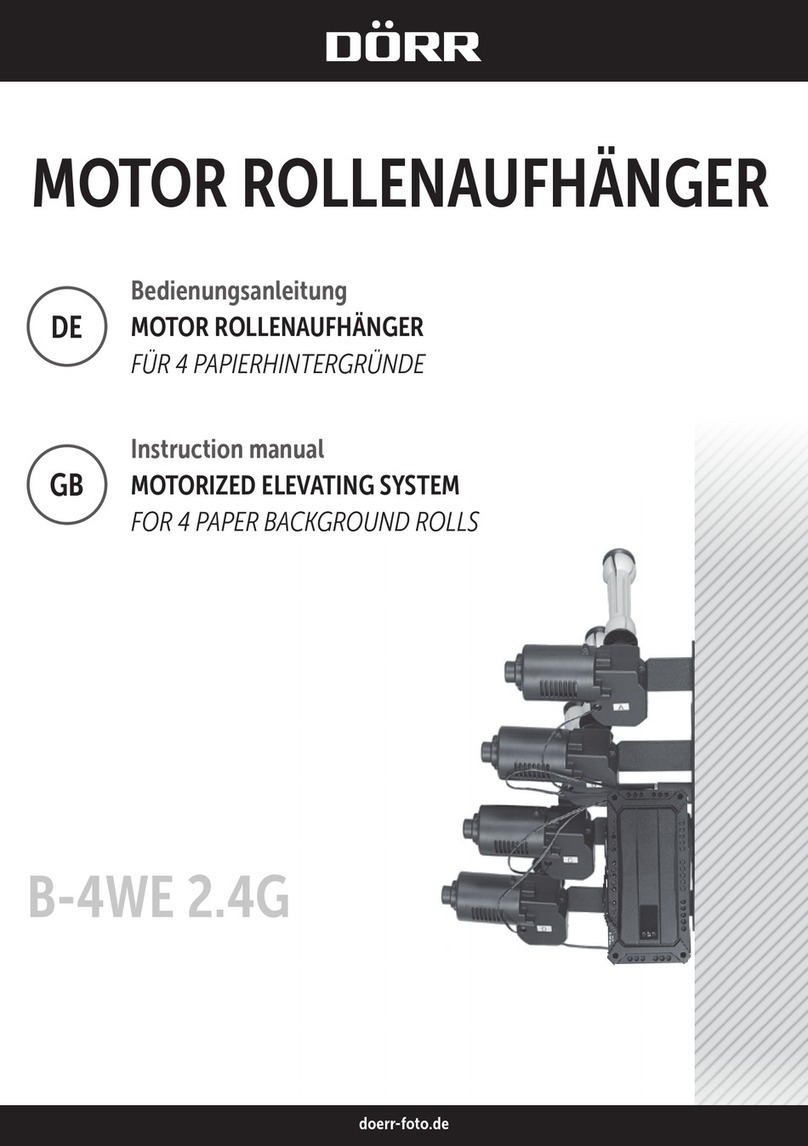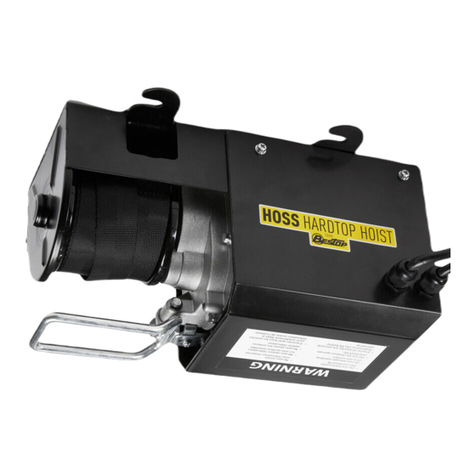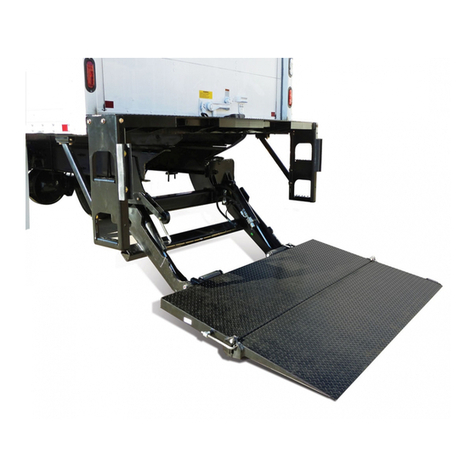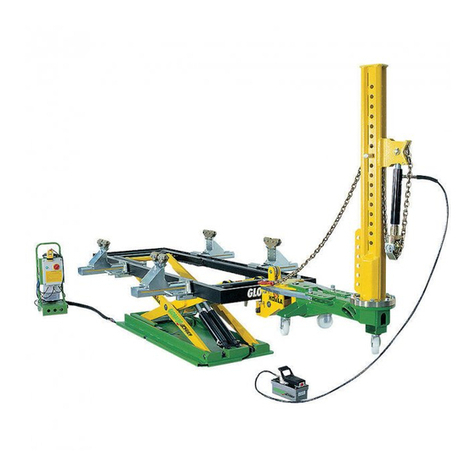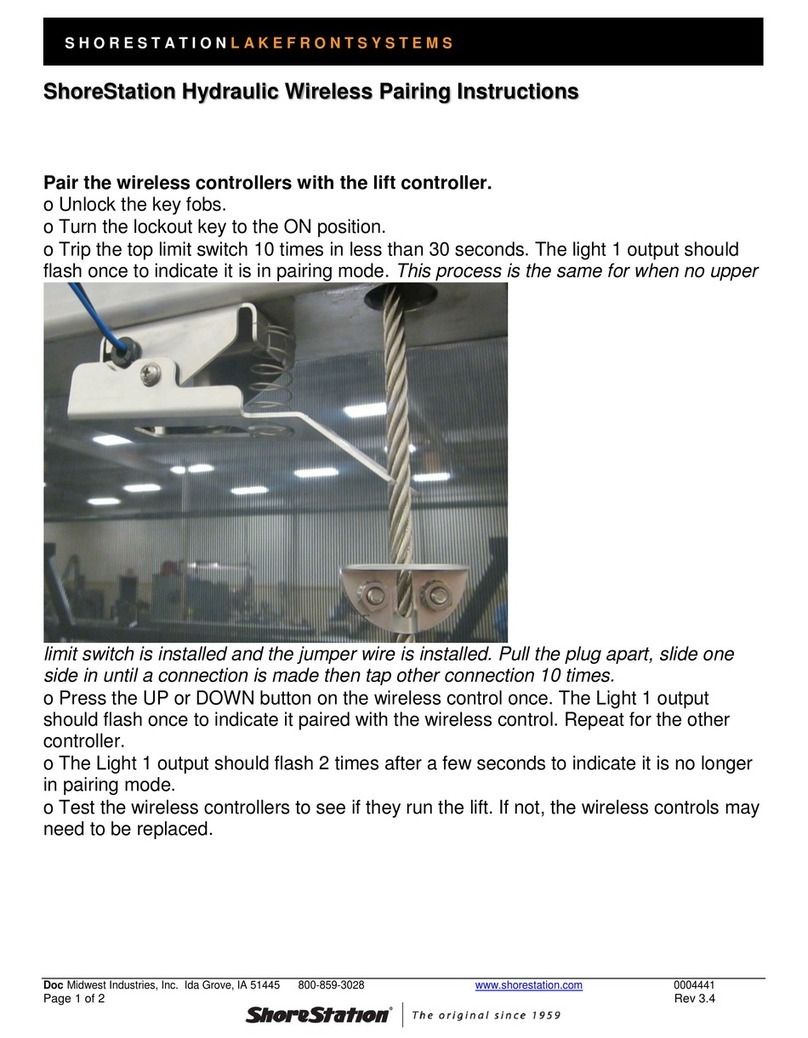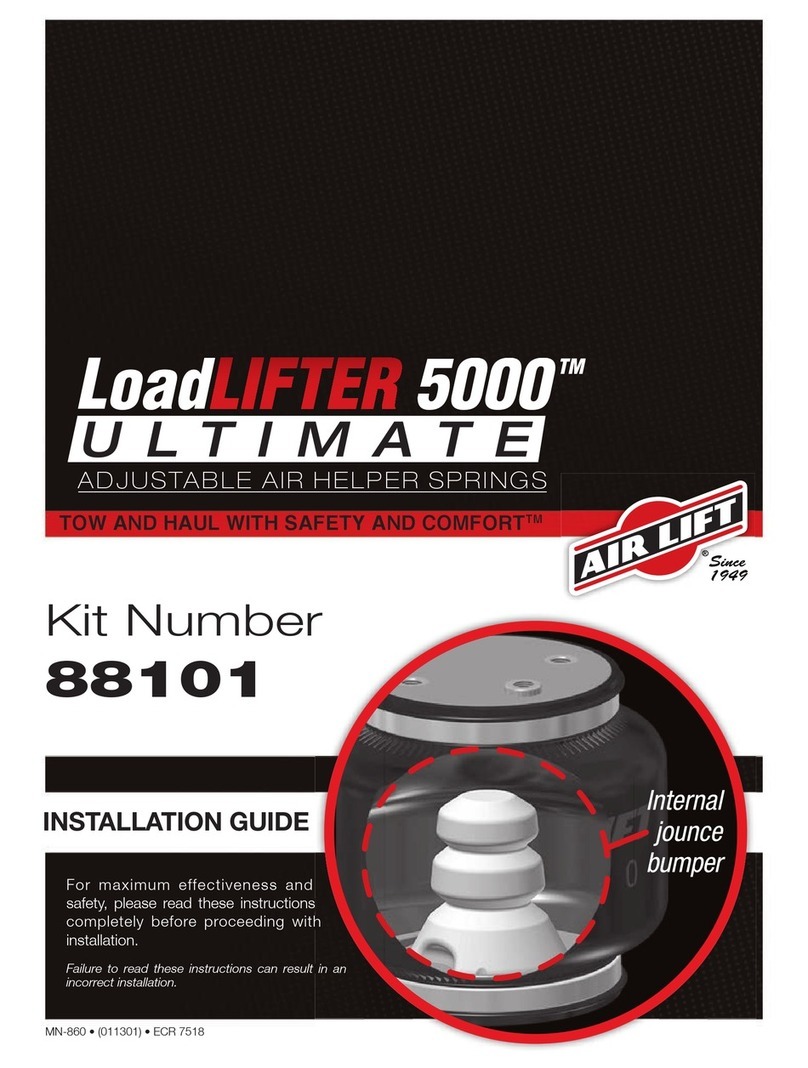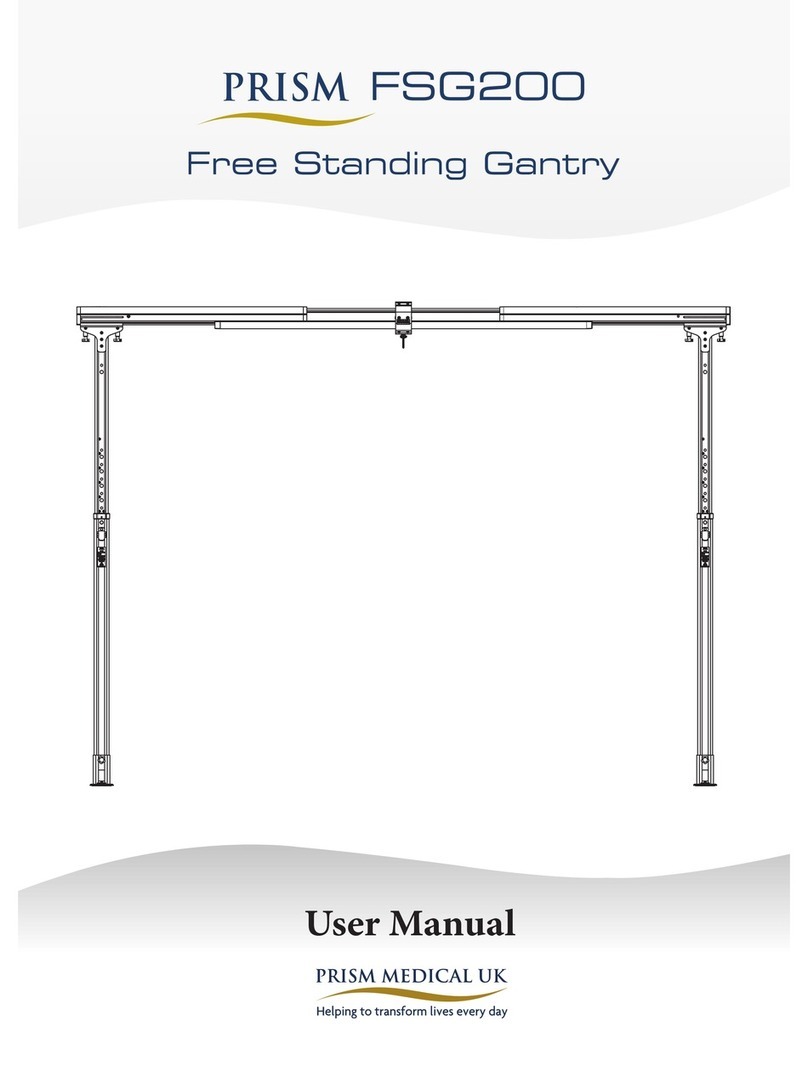DBI SALA Rollgliss R250 Rescue Kit User manual

Rollgliss®Rescue Kit
IMPORTANT: Rescuers of people suspended at height must always
protect themselves from the risk of injury and falls. This kit is a
highly effective system for performing a rescue. However simply
owning the kit itself is not a replacement for effective rescue training.
As with any tool, its effectiveness is highly dependent on the people
using the equipment. Only people who have been trained in the
use of this product should attempt to use it to perform a rescue.
Ongoing practice in performing a rescue to ensure completion
with a high degree of personal safety is highly recommended.
Installation and Operating
Instructions

2
Rollgliss Descender
with Carabiners,
Rope and Safety
Hook
Extension Pole
Carrying Bag for
Extension Pole
Carrying bag for Kit
Anchorage Strap
Safety Rope
to secure
Extension Pole
Rollgliss
Mini‑haul System
Gripping Handle

3
Description
Although available for use for rescue professionals, the
Rollgliss
®
rescue kit has been designed as a peer rescue
system for use in industrial environments. The kit has been
designed specically to enable a rescue to be performed by a
person or persons where rescue is not part of their normal job
function. It is to be used by the rescuer(s) to remove a person
from danger without putting themselves at risk by descending
to them.
Unlike many rope rescue systems, the Rollgliss
®
rescue kit
does not require complex knots to be tied or improvised haul
systems to be set up. The use of knives is also not required
to remove the casualty from their existing fall arrest system,
making the system even safer. Most importantly, the user can
either be raised OR lowered to safety.
Kit Components
This rescue kit is a system for performing a rescue of
someone suspended at height. The kit includes the following
components:
1 x Rollgliss
®
Lory R250 descender with carabiners, rope and
safety hook
1 x Extension pole
1 x Rollgliss
®
mini‑haul system
1 x anchorage strap
2 x carry bags (1 for the pole and 1 for the remainder of the
kit)
1 x usage instructions
Usage Instructions
Prior to completing the rescue:
Seek medical assistance/support - Once someone has
taken a fall and is suspended, complete an immediate mental
risk assessment. Even if the person is not injured or is not
unconscious, it is recommended medical attention/assistance
be immediately sought. Follow your site rescue plan and
notify appropriate personnel that if required, you are going to
perform a rescue.

4
Teams work best - Although a rescue using this device can be
performed using one person, a second person is highly recommended
to assist. The rescue should always be performed above the location
where the person is suspended. If access to the location for anchoring
the system can be achieved without fall protection equipment, use
this approach rst.
If fall protection equipment is the only option, the rescuer must be
a suitably trained/competent person to work at height. They should
put on an approved full body safety harness, ensuring it is correctly
adjusted, and commence the climb/descent to the location. The
rescuer shall remain fully protected from a fall at all times using
the appropriate combination of twin lanyards, SRLs lifelines or other
suitable equipment.
The second person should wait at the bottom of the work area to
assist with the descent and/or instruct and direct medical support
when it arrives, or to administer rst aid.
Communication - Keep verbal contact with the person suspended
at all times. Ongoing communication will enable you to maintain an
understanding of their physical condition and to determine if they
are deteriorating. Try to get them to remain as calm as possible but
to keep moving their legs while trying to move into a position that is
as comfortable as possible.
Suspension Trauma – Following a fall, it is important that the
person suspended is removed from the situation as quickly and safely
as possible to reduce the chance of any impact from orthostatic
intolerance, more commonly known as suspension trauma.
Depending on the nature of the fall, the type of equipment in use
and the casualty’s physical condition prior to and during the fall, the
most severe effect of extended suspension can be death.
Suspension trauma can occur when blood circulation is impeded
from a lack of movement of the legs during suspension. This lack
of circulation is increased in risk by the restrictions of the harnesses
leg loops. Therefore, rescue must be performed as quickly as
possible to avoid this condition. It is important to understand the
special
conditions present post rescue and the rst aid considerations
necessary for workers experiencing suspension trauma.

5
Using the Kit
Step 1
Anchorage - Identify a suitable anchorage location for the anchorage
strap. Such a location should be rated for at least 3,300 lbs.
(15 kN). Remove the anchorage strap from the larger kit bag and
position as directly above the person to be rescued as possible.
This therefore avoids the potential
for the system components to
come into contact with sharp
edges or other obstacles that will
prevent correct functionality of the
equipment. Once the positioning
of the strap has been completed,
secure it in place by attaching the
carabiner on the descender to the
strap or other suitable anchorage
connector.
Step 2
Set the Rope Distance - Lower the large safety hook located at
the end of the rope down towards the D‑ring of the person to be
rescued. This may be a frontal or dorsal (back) D‑ring, however
the dorsal is recommended as it is usually the easiest to reach
and cannot be interfered with by the
rescue.
If the length of rope from the
descender is insufcient to reach
the rescuee, more rope can be fed
through the descender by slowly
rotating the red handle upwards,
while pulling the rope through the
descender. When the correct length
has been attained, rotate the red
handle back to its original position.

6
Step 4
Connection - While holding the rope along the length
of the pole to prevent the hook from disengaging,
lower the pole to the suspended
worker.
Fit the hook into the D‑ring of the
safety harness. Once the D‑ring is
well within the hook throat, pull the
pole upward to release the latch. The
hook should now be secured on to
the person to be rescued. Retrieve
the pole and place it in a secure
location out of the immediate work
area.
Step 3
Set the Pole length and hook - Once
the rope length has been determined,
retrieve the hook and keep it to one
side.
Remove the adjustable pole from the bag
and secure the safety rope at the base of
the pole to the structure to prevent it
being dropped during the rescue.
Extend the pole using the
adjusters to a sufcient length
to reach the person to be
rescued. Retrieve the pole and
then connect the hook to the
end in the open position.

7
Step 5
Remove Slack - Pull the excess/loose rope back through the
descender until no slack remains. This part of the rope is known as
the free end.
Step 6
Install the Haul System Top - Remove
the mini‑haul system from the storage
bag. Retract the locking mechanism on the
top ascender to enable the rope to slide
through it. Place the free end of the rope
(haul side) within the top ascender and lock
the mechanism in place. The top ascender
is the one with the free end of the mini haul
rope.
Step 7
Install the Haul System Bottom -
Retract the locking mechanism on the
bottom ascender to enable the rope to slide
through it. Place the ascender over the tight
rope (load side) between the descender
and the suspended worker’s D‑ring and
lock the mechanism in place. Attach the
gripping handle to the free end of the mini‑
haul system rope.
Step 8
Raise the rescuee - While holding the gripping handle in one
hand, pull the free end of the haul system. The pulleys will travel
together to lift the person to be rescued in an upwards motion.
During this action, the person will be held up by the descender. If it
is necessary to repeat this step, the ascenders can be re‑positioned
simply by moving the top ascender up towards the descender and
sliding the bottom ascender down towards the rescuee. This step
may be required to be performed multiple times to enable sufcient
slack to be created in the rescuee’s primary fall arrest device.

8
At this time, the decision on whether to raise or lower the person
being rescued needs to be made. There are many factors to reaching
this decision such as:
• Obstacles below the person
• Level/nature of injury
• Location of medical assistance
• Time of suspension
In most cases, it will be easiest, quickest and safest to lower the person;
however this can only be determined in the specic circumstances
faced during the event.
Step 9
Secondary system in place - DBI‑SALA always promotes the use of
both a primary and secondary system of protection while working at
height. This also applies to person being rescued. If the person being
rescued is retained in position by a self‑retracting lifeline (SRL), then
if there is sufcient length in the lifeline, the motion of raising them
should unlock the device and allow them to be lowered to the ground
with both the rescue device and SRL in place to protect the person
from further fall.
If the person has been retained by a deployed shock absorbing
lanyard, the raising motion will allow their lanyard to be unhooked
from the anchorage and to be lowered, however this will not enable
a secondary device to remain in place. Once again, there may be
insufcient time to attach a secondary device, however this underlines
the importance of ensuring the person is properly retained prior to
removing their lanyard.
Either way, prior to the descent, the mini‑haul system pulleys must
be removed from the rope. Loosen the locking mechanisms of
the ascenders by sliding them on the haul rope, then unlock the
mechanisms and remove the ascenders from the rope
Step 10
Lower the person being rescued to safety – Prior to lowering the
rescuee take the free end of the rescue rope and loop it through a
second carabiner (not provided in kit) attached to the anchor strap.
The rescuer will maintain a grip on the free end during the descent

9
and will help control the descent speed
with their grip on the free end of the rescue
rope.
NOTE: The use of a second carabiner
is optional. You may decide it is not
required for your application
With the other hand, lift the red handle on
the descender to commence lowering the
person to the ground.
IMPORTANT: Be sure to keep ngers, hair, other rope and
other materials well away from the descender device during this
motion to prevent entanglement.
Note that this is a friction descent device
and the rate of descent of the person is
controlled by the operator within a band
of adjustment. The device has a dead‑man
handle feature that will prevent the rescuee
from descending if the rescuer lets go of
the handle at any time. In addition, if the
rescuer opens the handle too far the device
will lock off. To unlock the device and
continue descent, the rescuer must move
the handle back to its original position tight
against the descender.
WARNING: During descent the casualty can reach a signicant
speed and care needs to be taken to ensure the lowering action
is gentle to avoid the possibility of any further injury.
In addition, if the person is still attached to an SRL, the device may
lock off prematurely again, requiring steps 6 to 9 to be repeated,
increasing the length of time the rescuee remains suspended.
Step 11
First Aid - The person at the bottom of the working platform should
now be able to touch the rescuee. The second rescuer should grab
the rescuee’s legs in each hand and ensure they are kept in a bent
position . Do not bring the person’s legs together – it will be very
uncomfortable for them while still suspended in the harness.

10
Once the rescuee’s buttock also reaches the ground, the second
rescuer should move behind them and ensure they remain seated
upright until medical help arrives. If the rescuee has been suspended
for some time, this is the period they can be most severely
impacted by a sudden rush of blood to the heart, causing blackout
and/or death. Only trained medical staff should attempt to treat the
person. The casualty should be kept calm and whether conscious or
unconscious their neck should be supported and kept in an upright
position to minimize spinal injury and ensure the airway is kept open.
Any open, bleeding wounds should be attended to as a matter of
urgency.
Inspection
After the rescue is compete, inspect the system. Check the
entire rope for any cuts or knots. Inspect all metal parts for any
deformations or cracks. Inspect all labels to make sure they are
present and legible. Clean any parts that have become soiled or
coated with foreign materials. Carefully pack all items into their
appropriate bags so everything is ready for any future rescues.
Summary
The Rollgliss®Rescue Kit is an effective tool to enable a rescue to be
completed from a fall from height. It is a complete rescue system,
however all person’s using the equipment MUST BE trained to ensure
that it can be used correctly and effectively.
Always remember these key principles:
• Always seek medical and rescue support as rst action
• Always take the safest option. Avoid putting someone in a position
where there is a need to rescue the rescuer or place their life in
danger.
• Maintain constant and positive communication between the person
being rescued, the medical support people and the rescue team.
This will reduce panic, lessen the risk of injury and enable medical
conditions to be treated as quickly and as accurately as possible.
• Repeat rescue training frequently using this equipment to ensure
you are always prepared for any fall from height event requiring a
rescue.

11
9.0 INSPECTION AND MAINTENANCE LOG
SERIAL NUMBER:
MODEL NUMBER:
DATE PURCHASED:
INSPECTION
DATE
INSPECTION
ITEMS NOTED
CORRECTIVE
ACTION
MAINTENANCE
PERFORMED
Approved By:
Approved By:
Approved By:
Approved By:
Approved By:
Approved By:
Approved By:
Approved By:
Approved By:
Approved By:
Approved By:
Approved By:
Approved By:
Approved By:

Form N0: 5902355
Rev: A
WARRANTY
Equipment offered by DBI‑SALA is warranted against factory defects
in workmanship and materials for a period of two years from date
of installation or use by the owner, provided that this period shall
not exceed two years from date of shipment. Upon notice in writing,
DBI‑SALA will promptly repair or replace all defective items. DBI‑SALA
reserves the right to elect to have any defective item returned to
its plant for inspection before making a repair or replacement. This
warranty does not cover equipment damages resulting from abuse,
damage in transit, or other damage beyond the control of DBI‑SALA.
This warranty applies only to the original purchaser and is the only
one applicable to our products, and is in lieu of all other warranties,
expressed or implied.
USA Canada
3965 Pepin Avenue 260 Export Boulevard
Red Wing, MN 55066‑1837 Mississauga, Ontario L5S 1Y9
Toll Free: 800‑328‑6146 Toll Free: 800‑387‑7484
Phone: (651) 388‑8282 Phone: (905) 795‑9333
Fax: (651) 388‑5065 Fax: (905) 795‑8777
www.capitalsafety.com www.capitalsafety.com
This instruction manual is available for download at www.capitalsafety.com
A Capital Safety Company
Table of contents
Popular Lifting System manuals by other brands

BrandSafway
BrandSafway SPIDER GLAZIER 2200 Operator's manual
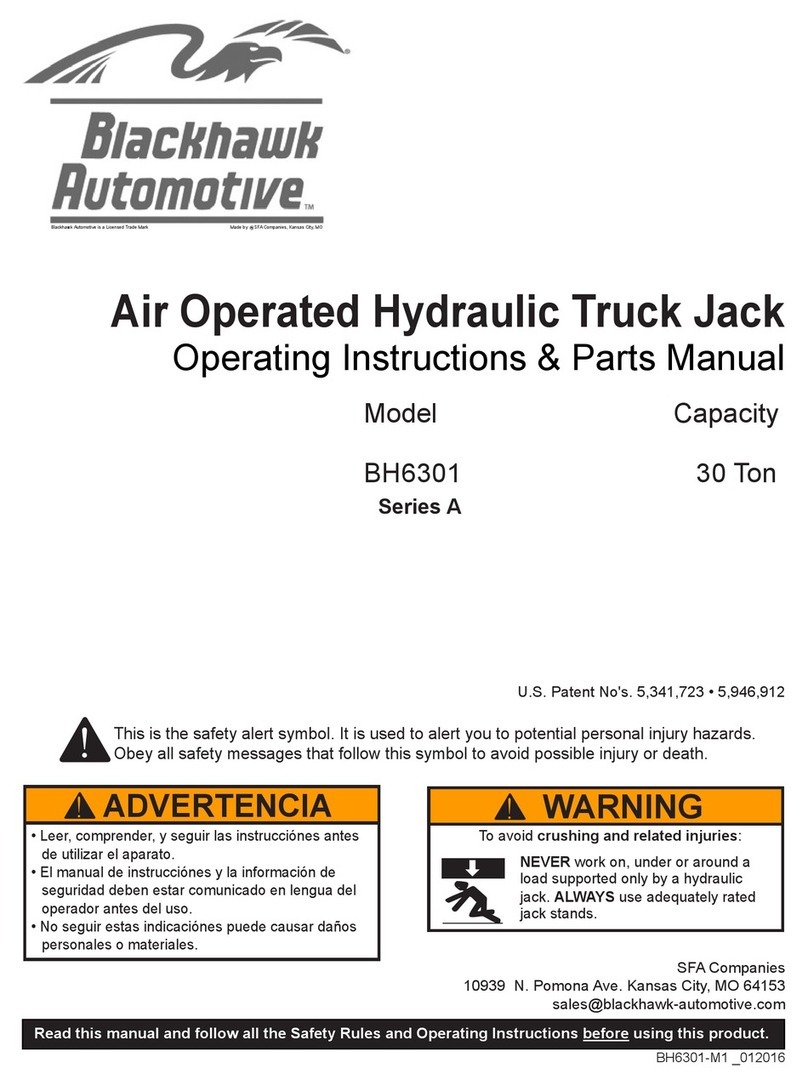
Black Hawk Automotive
Black Hawk Automotive BH6301 Operating instructions & parts manual
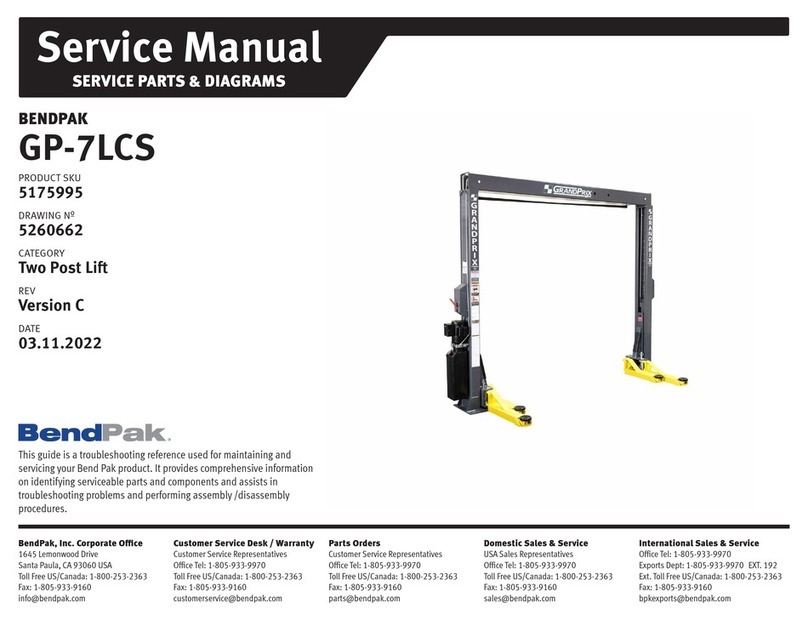
Bend-Pak
Bend-Pak GP-7LCS Service manual
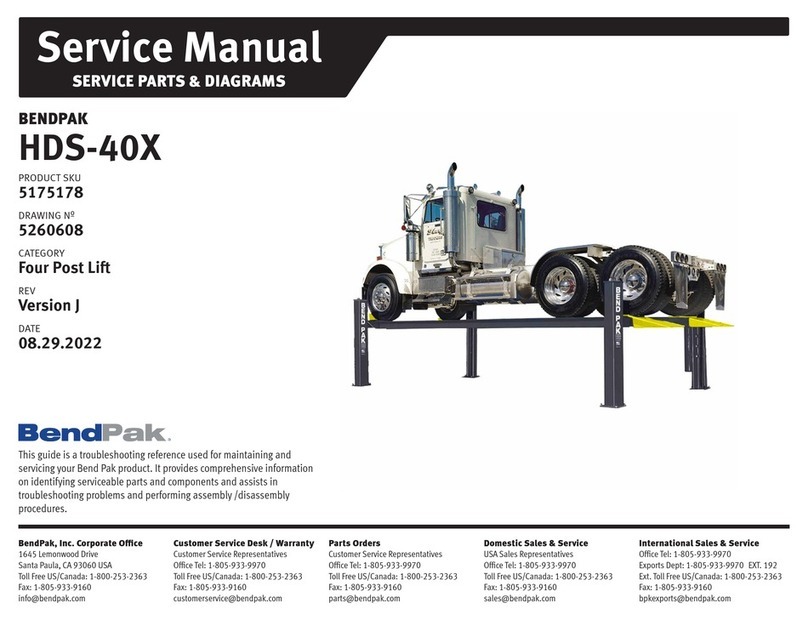
Bend-Pak
Bend-Pak HDS-40X Service manual

Bend-Pak
Bend-Pak LR-5T Service manual

Purpleline
Purpleline Kojack KJ4THL100 user manual
